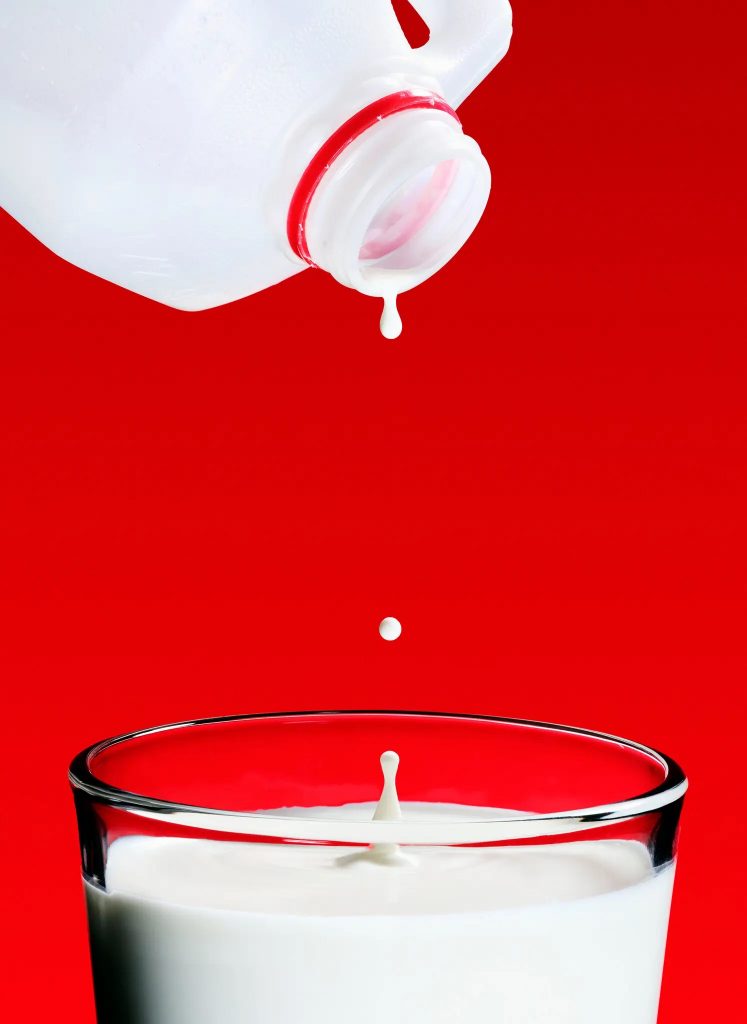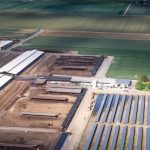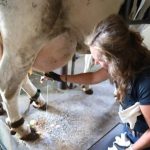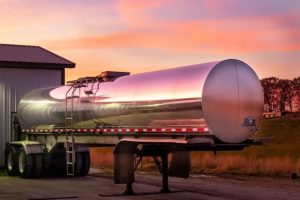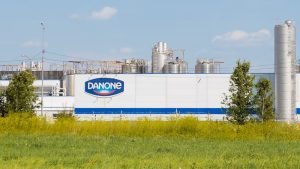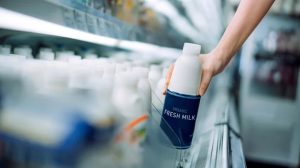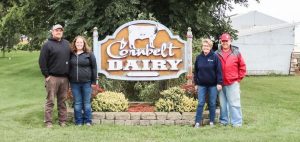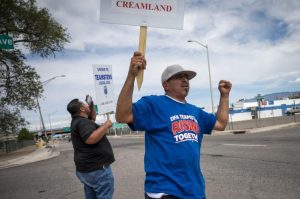
Undocumented labor quietly props up the entire American economy — but nowhere more dramatically than on dairy farms.
Four-thirty in the morning felt numbingly cold in southern Idaho when it was Rosa’s turn to usher the cows into the milking parlor. Striding through the dairy farm’s open lots, she tried to balance speed with caution. April showers and the hooves of roughly 2,000 cows had transformed whole sections of the lots into a slippery goo of dirt, dung and urine. The muck stuck to her rubber boots; it was treacherous. On at least one occasion, she had fallen in it.
“If you don’t know how to skate, you learn here,” she told me in Spanish. “This is better than an ice rink.”
Her headlamp sliced images out of the dark as she walked. Cows rising grumpily from the dirt. Cows chewing feed piled along fences. Cows defecating as they sauntered from one side of a corral to another, their swollen udders bulging several inches behind their haunches. She nudged most of them along just by clapping her hands, shushing loudly or flapping her arms like a duck.
Close to the milking parlor, things got tricky. The goo was thicker here, where hundreds of cows passed every hour, and Rosa needed the animals to squeeze together inside a holding area. She stepped in closer to smack haunches, then darted back before the cows turned in response. She was small, and they were huge. Their backs came up to her shoulders — each of them weighed at least 1,000 pounds. There are a lot of ways to get hurt on a dairy farm, and being crushed by cows is one of them. The animals are languid and gentle, but they startle easily. In a panic, they can move fast.
Rosa’s boss, a man named Peter, allowed me to follow her around the dairy because he believes that more people need to understand how economically precarious America’s production of milk has become. The problem, as Peter sees it, is that the price of everything in America has gone up except the price of milk. In the 1980s, a tractor cost him roughly $60,000, the federal minimum wage was $3.35 and his first hundred pounds of Class III milk — the kind used in making yogurt and cheese — sold to a processing plant for $12.24. Since then, many of his expenses have doubled or tripled. During the Covid-19 pandemic, Peter says, his costs soared, and they still haven’t come down. Fuel-tank fittings that cost him about $2,000 in 2014 now run $13,000. Mechanics who once charged $60 an hour now charge $95.
Yet the farm value of milk has been dropping since the 1970s, if you adjust for inflation. For consumers picking up a gallon at the supermarket, this is a blessing. It’s the reason long-term inflation for store-bought milk is roughly half that of other foods in America. But for Peter, it’s a tragedy. When we talked this past spring, the selling price for a hundred pounds of Class III milk hovered around $15.50 — roughly $3 above where it was 40 years ago and a 55 percent drop in real value.
Week to week the farm value of milk can jump up and down drastically, but it also has long-term trends, Andrew Novakovic, an expert on dairy economics at Cornell University, explained. Over the past five years it has swung between $11.66 and $25.46, but the overall trend is down. Every time it dips below $18, Peter runs his dairy at a loss.
If Peter owned a restaurant or a hardware store, he could set prices to keep his profits reasonable. But milk is a commodity, and to the average buyer, one dairyman’s milk is indistinguishable from another’s. So Peter, like almost every dairyman in the country, sells his milk through a co-op. Twice a day an insulated truck drains about 75,000 pounds of freshly pumped milk from his holding tanks. A couple of weeks later, Peter finds out what he will be paid in return.
“We’re not price makers,” Peter said. “We’re price takers.”
Over the years, Peter and his family have found ways to manage the declining value of milk. They’ve built fences out of recycled oil pipes, used brewers waste for cow feed, rented fields to grow their own alfalfa. They hedge the price of milk in futures markets and purchase revenue insurance. But the biggest cost that they can control is the cost of labor. And the productivity of his dairy — and of almost every successful dairy in America — now depends overwhelmingly on immigrants.
Image

After November’s elections, a reckoning for the dairy industry could quickly become a national concern. At the Republican National Convention in July, attendees waved signs demanding “mass deportation now!” — signaling their enthusiasm for former President Donald Trump’s promise to deport millions of undocumented residents if voters return him to the White House. His longtime adviser on immigration, Stephen Miller, told The Times that a second Trump administration would conduct large-scale workplace raids and sweeps of public places. Democrats, for their part, have met these threats with relative silence, a sign of the public’s growing intolerance for migrants: At the Democratic convention in August, a panel discussion about the future of comprehensive immigration reform drew fewer than two dozen people. The party that once championed the idea of granting permanent legal status to undocumented minors now speaks more often of reducing applications for asylum.
Peter himself does not actually know Rosa’s immigration status. He estimates that more than 90 percent of his employees were born in Mexico, but the documents that these men and women presented when they were hired appeared legitimate. Under current law, Peter is not required to do much more than glance at them. Like the rest of the dozen dairy owners I spoke with in Idaho, he preferred not to question employees too closely about their immigration status. A Social Security number written on a hiring form was enough.
What Peter does know, however, is that without foreign-born workers, his dairy could not stay afloat. Americans are understandably reluctant to perform dirty, dangerous and demanding work — what economists call 3-D jobs — as long as they have better alternatives. Unemployment in southern Idaho has averaged 3.4 percent for a decade; wages for entry-level workers on Peter’s farm are competitive with those for cashiers at fast-food franchises. He can’t pay much more, he insists, and still break even.
When I mentioned to Pete Wiersma, the president of the Idaho Dairymen’s Association, that I’d read a study predicting that the price of milk would nearly double if foreign-born workers were removed from the industry, he shook his head.
“I don’t think there would be milk,” Wiersma said. “I just don’t think we could get it done.”
As a teenager in the 1970s, Peter often rose at 3 in the morning to milk 150 cows for his parents before catching the bus to school. A decade later, when he and his wife started their own dairy with fewer than 100 cows, they did all the work themselves, through freezing winters and broiling summers, never missing a day.
This is how American dairy farms often used to function: Their 3-D jobs were performed largely by owners and their children, many of them descendants of immigrants from Portugal and the Netherlands. But now dairy farms of all sizes — small farms in New York where herds average around 200 cows, and enormous farms in the Texas Panhandle where herds average 4,000 — depend upon workers who come mostly from Latin America.
For Peter, and for the dairy industry nationally, the shift became noticeable in the 1990s. Peter’s first employees had been local Americans. One milked his growing herd in the morning, the other handled afternoons. But neither would commit to both shifts. Back then each milking took fewer than five hours, but they started about 12 hours apart.
His American employees pieced together dairy work with other part-time jobs that had better long-term potential, like working in Nevada casinos. Then someone put Peter in touch with a young man who had recently arrived from Mexico. “He was anxious and willing to do both shifts, no problem,” Peter recalled. He stayed at the dairy for 15 years.
These days, working as a milker in a dairy is a lot like working the assembly line in a factory: fast, repetitive and exhausting. Rosa’s brother-in-law, whose nickname is Pepe, told me that when he first began milking cows in Idaho roughly a decade ago, his hands swelled up from the repetitive squeezing and his feet cramped from the long hours of standing. At night, terrible leg pains woke him from deep sleep.
The procedure looks deceptively simple: A crew of workers stands in a narrow galley between two lines of stalls set on raised floors. When a cow enters a stall, its udder hangs near the milker’s shoulder. The milker sprays the udder with “pre-dip” (a chemical solution containing chlorine dioxide) and squeezes each teat to prime the cow for milking. The teats are then wiped clean with a microfiber cloth. The milker attaches them to an automatic milking machine and presses a button to start the pumping action. The machine can empty a full udder in about five minutes. Afterward, the milker dabs each teat with a sticky solution that reduces infections. When all the cows on one side of the parlor are milked, they exit toward their next meal. The worker then grabs a hose that pours out disinfectant (water mixed with chlorine dioxide), rinses the automatic milkers and sluices the muck off the raised floors as more cows saunter in.
Image

In Mexico, Pepe managed a shoe store. But in 12 hours of milking in Idaho, he earned three times as much as he did during 10 hours as a manager. Within a month, the pains and cramps disappeared. Soon he was promoted to shift leader. He got used to the muck and the long hours, but he could never get comfortable with the itchy feeling of being disrespected by his employers. His first American boss ignored him when he said hello, and his first supervisor screamed at him for chatting with the other milkers in Spanish. They were expected to work their 12-hour shifts in silence. Outraged, Pepe quit.
So after a few years, Pepe returned to milking. He felt lucky to have landed at Peter’s dairy, where the managers didn’t yell and the owner actually learned the names of his employees.
Most of Idaho’s dairy farmers are conservatives, and the state is so red that the elections that usually matter most are the Republican primaries in the spring. Trump won the state by a landslide in 2020. But Idaho’s Republican primaries are now often a referendum on immigration policy, with some conservatives arguing for deportations and others for immigration reform.
Dorothy Moon, the chairwoman of Idaho’s Republican Party, published a column in Twin Falls’ local newspaper, The Times-News, in 2023 arguing that Idaho needed to rid itself of undocumented workers. “Everywhere immigrants are relied upon to fill the work force, domestic-worker compensation, including young workers recently graduated from college, drops dramatically,” she wrote. “Everywhere immigrants are relied upon to fill the work force, welfare spending increases.”
Even Idahoans may underestimate the effect that a serious crackdown on undocumented immigrants could have on the dairy business. After Trump entered the White House in 2017, the Department of Homeland Security issued a memo that made the deportation of every undocumented immigrant a priority. The federal action and the news of widespread deportations in other parts of the country created a climate of fear and intolerance, which the Idaho Dairymen’s Association tried to stem. It gathered more than 3,000 signatures on a petition about the labor shortage in the dairy industry. It organized a pro-immigrant alliance of faith leaders, elected officials and law enforcement — and became a vocal supporter of comprehensive immigration reform.
But the battle over undocumented labor did not abate. This year politicians in Boise tried twice to pass House bills condemning the “invasion” of immigrants and the “thirst for cheap immigrant labor in Idaho.” The second bill failed only on a tie vote.
In February, the state representative Jordan Redman sponsored a bill, H-510, that allowed the state’s attorney general to revoke the business licenses of people found employing unauthorized workers. It also included a provision that allowed any resident of Idaho to petition the attorney general to bring an enforcement action against a specific business or employer, essentially encouraging Idahoans to turn against each other. Redman, who comes from a district in northern Idaho, told me that one of his priorities was ensuring a level playing field for businesses that did not hire undocumented workers and, therefore, might pay higher wages and more taxes.
“I don’t have a ton of dairies up in my neck of the woods,” he said. He was surprised when many of his colleagues opposed the bill. In the end, H-510 never came to a vote, but Redman still supports the ideas behind it. “I don’t think that kind of turning a blind eye to certain laws that we already have in place to benefit specific industries is the way we should govern,” he said.
In March, nine state representatives, including Redman, put forward another bill, H-753, stepping up actions against undocumented immigrants. Their bill passed by a vote of 53-15 in the House but never came to a vote in the state Senate.
“I don’t think anyone really thinks that this is going to help Idaho,” Philip Watson, an economist at the University of Idaho’s College of Agricultural and Life Sciences, told me when we discussed these legislative efforts. “There’s just this idea that this is what we have to be doing because it’s the right thing to do.”
He compared the bills floated by hard-right conservatives in Idaho with “cap and invest” legislation passed in Washington State that effectively raised gas prices while curbing carbon emissions. These were policies that aligned with many voters’ feelings — about climate change, about immigration — but hurt state businesses. In Idaho, he said, the economic effects would be more painful because dairy has become such a big part of the state’s economy. Idaho is now the third-largest dairy producer in the United States.
According to studies done by Watson and his colleague Hernan Tejeda, the dairy industry brought $10.7 billion into Idaho in 2020. That number includes revenue generated not only by milk producers like Peter but also by milk processors. The state’s best-known processing plant belongs to the Greek yogurt maker Chobani, but its largest is owned by Glanbia, which makes the kind of nonbrand cheese used by Domino’s and Pizza Hut. Idaho milk is also the basis of generic cheese sold in value stores like Walmart.
In a 2012 study, Watson estimated that if Idaho cut its supply of foreign-born, less-educated labor by 50 percent, the state’s G.D.P. would fall by $905 million. In 2024, he told me, that number would only be bigger. The dairy industry generated about $155 million in state and local tax revenue in 2020, he noted, compared with $90 million in 2012. Idaho’s dairy farms may employ only 4,400 people, Watson and Tejeda have found, but those farms enable 30,600 other jobs in milk processing and other supporting businesses. If the industry departed, it would affect Idaho broadly, including schools and restaurants across the state.
“People have seen this for decades,” Watson said. “When the coal mine shuts down in West Virginia or the steel mill shuts down in Pittsburgh, it’s not just the mill and the millworkers that are affected. It’s entire communities.”
Image

At 5:30 one morning, four of Peter’s most valued employees gathered in an office near the milking parlor. Although these men all began as milkers, over time they were promoted into roles performing some of the most sophisticated work on the farm: administering vaccinations, pulling calves, diagnosing and treating common illnesses like mastitis, artificially inseminating cows. In a few minutes, the men would brave a freezing drizzle to check every single cow in the corrals in preparation for a veterinarian’s routine visit.
More than Rosa and Pepe, these were the men Peter feared losing. Skilled, experienced, reliable dairy employees like them are even harder to replace than milkers. Without them, there would probably be deaths in Peter’s herd. When the Trump administration cracked down on undocumented workers in 2017, crop farmers found relief in the agricultural “guest worker” program, H-2A, which allows them to recruit adults in foreign countries to enter the United States for up to a year at a time on temporary visas. From 2016 to 2020, the number of H-2A visas issued by the government grew by 59 percent, bringing in more than 200,000 foreign-born farm workers.
For decades, dairy-industry leaders and their political allies — notably, Representative Mike Simpson, Republican of Idaho, and Patrick Leahy, the former Democratic senator from Vermont — have tried to pass federal legislation to allow dairy farmers into this program. But H-2A is meant to help farmers handle seasonal spikes in labor needs. Dairymen are currently barred from the program because the work in milking parlors and corrals is not seasonal — it’s year-round. The last time dairymen came close to winning an expansion of the program was in 2022, with the Farm Workforce Modernization Act, which would have allowed year-round agricultural businesses to import workers for three-year stints and would have also required all agricultural employers to electronically verify the work authorization of their employees using the federal database program commonly known as E-Verify. The act would have also allowed all currently undocumented farmworkers to obtain a temporary legal status for themselves and their families and would have established a pathway for them to achieve legal permanent residency.
The four men standing in Peter’s office that icy morning were, in effect, the reason the Idaho Dairymen’s Association wanted this last provision. All of them had learned their jobs over the course of more than a decade of hands-on training. Peter cannot afford to lose all of them at once, through deportation or through mandatory E-Verify. And because they are already living in the United States, they would not be eligibile for H-2A visas.
But the idea of granting them a path to legal permanent residency proved a deal-breaker when members of the right portrayed it as a kind of amnesty. The Farm Workforce Modernization Act had already passed in the House when negotiations between Senator Michael Bennet, Democrat of Colorado, and Senator Michael D. Crapo, Republican of Idaho, broke down and Crapo withdrew his support. After that, it was no surprise when similar legislation proposed by Bennet failed on a floor vote.
But objections to the act came from the left as well. Many dairy workers and their advocates also opposed the bill because they believed it would make it harder to improve workplace conditions.
“It’s a model that provides workers to farms that have a need, but it’s not a model to ensure that those workers are treated well,” Teresa Mares, an anthropologist at the University of Vermont who has studied the dairy industry, said of the H-2A program.
Working in a milking parlor today no longer looks the way it did in the 1970s, or even the 1980s. In many ways, the work is safer and cleaner — back then it was common for milkers to get knocked out by kicking cows. But it’s also more relentless.
Image

Peter’s business, like most dairies in Idaho, is now a 24/7 operation. His crews milk more than 100 cows an hour, producing more than 130,000 pounds of milk a day. They work 11- or 12-hour shifts, with only a 30-minute break for lunch. The rest of the time, they are on their feet and in constant motion. The speed with which they milk each set of cows is monitored by computer.
In Wisconsin, ProPublica discovered that dairies operate with little or no safety oversight. In New York, milkers normally work 12-hour shifts, six days a week, even after reform legislation was passed in 2019.
Peter’s milkers have every fourth day off, and he feels insulted when people accuse dairy farmers of wanting indentured servants. His own parents used a sponsorship program when they came from Europe after World War II; it allowed them to build their dairy operations in America, starting a generational climb.
“They had that start where somebody had faith in them and gave them a chance and honored them,” he told me in his kitchen. He wishes his immigrant workers could get a similar deal. But dairy farmers are practical — the cows must be milked — and in the end, he’ll settle for anything that gets him a crew willing to round up cows at 4 in the morning and keep them healthy, whether that means entering the H-2A program or looking the other way as applicants fill out hiring forms.
This summer, the Republican Party adopted Trump’s plan of mass deportations as part of its official platform. And a poll conducted by Scripps News/Ipsos in September found that most Americans — including a quarter of self-identified Democrats — now support the idea as well. They believe, one assumes, that whatever the humanitarian costs of such a program, America as a nation will be better off when these men, women and children are gone.
Is that true? About 8.3 million unauthorized workers lived in the United States in 2022, according to the Pew Research Center. It’s convenient to imagine that removing these adults from the labor force would create drastically more jobs and better wages for U.S. citizens — but that’s not likely.
“You’re not substituting, like, 500 nannies with 500 U.S.-born nannies,” the economist Joan Monrás told me. “I don’t think that’s ever going to happen.”
Monrás has published several academic papers studying the actual — as opposed to only theoretically modeled — effects of foreign migrations on labor markets. When I asked him to consider the case of child-care workers, he noted that some consumers will change their behavior rather than spend more money. Dual-income households, for example, might decide that one parent needs to quit. People have finite resources; they do not drive up wages in an endless auction. When gardeners are more expensive, more people mow their own lawns.
And, he noted, undocumented immigrants make up only a small fraction of the American labor force — about 5 percent in 2022 — so while their removal may create a lot of short-term disruptions, over the long run it won’t generate significant benefits.
Image

Monrás’s arguments have been buttressed by the Peterson Institute for International Economics, which recently modeled the potential effects of several of Trump’s campaign promises, including his proposal to deport 15 to 20 million undocumented immigrants. If a second Trump administration deported all the country’s undocumented workers, the institute found, the economy as a whole would largely stabilize after four years, with inflation and per capita G.D.P. returning to roughly their current levels.
But when it comes to food, the institute found, the consequences of mass deportation would be significant, immediate and lasting. Mass deportations would reduce the labor supply in agriculture not by 5 percent but by 16 percent. And prices in that sector would rise by more than 10 percent for the foreseeable future.
The reality may turn out even worse than the institute’s models suggest. Algorithms don’t account for the way that raising plants and animals differs from manufacturing cars or cleaning hotel rooms, nor can they reliably capture 21st-century Americans’ reluctance to perform 3-D jobs. When Georgia passed a strict immigration law in 2011 that included mandatory E-Verify, retail workers didn’t switch sectors to pick peaches; instead, crops rotted in the field.
“There aren’t a whole lot of people that grow up in the city that are looking to work 16-hour days during harvest time, to find out that twice a day you’re going to get cow dung splattered on your clothes or maybe on your pants and, God forbid, you might actually get some in the face,” the dairy economist Novakovic told me. “The reality is farmers have tried to hire people, and there is no price that they can offer that inspires somebody to come and do that kind of work. It’s too hard. It’s too dirty. It’s too unfamiliar.”
In the long run, more dairies might invest in robotic milkers if the price of milk rose high enough to justify the capital-intensive systems. But in the short run, the industry could be devastated. Apples go bad in the orchards if they aren’t picked within weeks, Rick Naerebout, the chief executive of the Idaho Dairymen’s Association, said, but cows must be milked within a day or two. “When she can’t get milked and she can’t get fed, she’s damaged beyond repair as a milk cow,” he said.
When the price of cheese crashed at the beginning of the pandemic, dairy farms dumped surplus milk into ditches. Not milking the cows was not an option. But if their foreign-born workers — half the industry’s farm-labor force — suddenly disappear, they may not replace them fast enough to save their herds.
Americans are exquisitely sensitive to their grocery-store bills, for good reason. You can trim expenses by mowing your own lawn or by staying home to watch your own children, but everyone needs to eat. So it’s not surprising that inflation on food prices has become a major issue in the current presidential campaign.
So has the issue of illegal immigration. But strangely, there has been very little consideration of the effects a more draconian immigration policy could have on food prices. The electorate has grown increasingly frustrated with undocumented migrants, while enjoying the bounty they make possible. A crackdown in a second Trump administration — or even one by Idaho Republicans — might rudely awaken them to just how interconnected the two issues are.
You can now read the most important #news on #eDairyNews #Whatsapp channels!!!
🇺🇸 eDairy News INGLÊS: https://whatsapp.com/channel/0029VaKsjzGDTkJyIN6hcP1K
